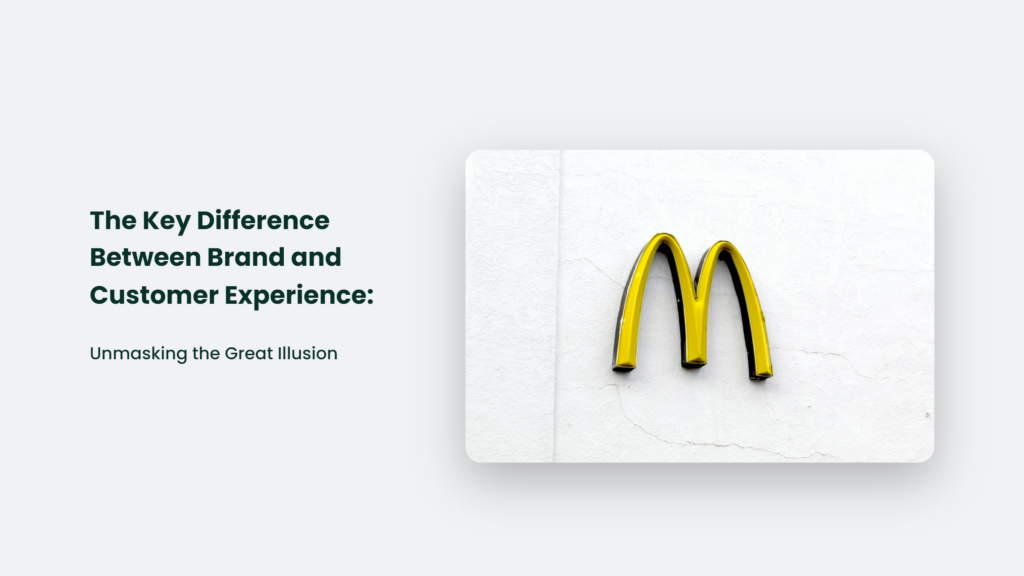

The Key Difference Between Brand and Customer Experience: Unmasking the Great Illusion

As Seen On
In the cutthroat business realm, terms like “brand” and “customer experience” are tossed around like confetti at a parade. But are they as interchangeable as a pair of socks in your drawer? Not even close.
In this article, we will look at the difference between brand and customer experience. So, without further ado, let’s dive in.

A Brand: More Than Just a Logo
Ah, ‘brand’. We’ve all heard the term, right? Perhaps, you think of it as a slick logo, a catchy jingle, or even a clever slogan. Well, it’s high time we debunk that notion. A brand, dear reader, is not just a logo – it’s a promise. A brand is the perception people have of your company. It’s the story you’re trying to tell, the values you project, and the reputation you build in the market.
A Harvard Business Review article eloquently noted, “Your brand is your strategy.” And it’s as solid a quote as a rock on a mountain. A strong brand gives you a competitive edge, amplifies your value, and builds trust with your audience.
In 2022, Apple was ranked the most valuable brand worldwide, valued at $947 billion. Is that because they’ve got a sexy, half-eaten apple as a logo? Hardly.
Customer Experience: The Star of the Show
Now, let’s talk about the customer experience – the star of our show. The customer experience is, in essence, your customers’ holistic perception of their interaction with your business. It’s about how they feel when they navigate your website, call your customer service, or walk into your store. It’s the emotions and attitudes your customers associate with your brand.
Now, let’s not kid ourselves – customer experience matters. A lot.
According to the 2020 PWC report, 32% of customers would stop doing business with a brand they loved after just one bad experience. Ouch, right?
Imagine this – you buy a phone from a company, let’s call them “FruitPhone”. FruitPhone is notorious for its crisp branding. However, when the phone starts bugging, and their customer service keeps bouncing you around like a pinball – what good is that glossy brand?
The Interplay: Brand and Customer Experience
So, the million-dollar question is – how do the brand and customer experience interact?
Well, picture your brand as the lovely house you’ve built and the customer experience as the welcoming party you throw inside. Your brand sets the expectation, and the customer experience delivers on it. It’s like yin and yang, salt and pepper, Simon and Garfunkel – they complete each other.
Let’s delve into an example. Remember the Volkswagen emission scandal? VW, a brand long associated with reliability, faced a significant hit when the news broke out.
It wasn’t just about falsifying emission data. It was about breaking customer trust – a critical part of their experience.
Therefore, dear reader, creating an epic brand is only half the story. To clinch the deal, you need to provide an exceptional customer experience. After all, who wants a beautifully wrapped present only to find a lump of coal inside?
Difference between Brand and Customer Experience: Trust, Loyalty, Perception
Ah, the trinity of success in the world of brand and customer experience: Trust, Loyalty, and Perception. Much like the three musketeers, they are inseparable and formidable together.
When we dive into the cosmic ballet of brands and customer experience, the golden thread linking the two is ‘Perception.’ Like an invisible puppeteer, perception silently orchestrates how customers interact with your business, how they feel about it, and ultimately, whether they stay loyal or venture elsewhere.
So, what’s the role of a brand in all this? Think of your brand as a painter and perception as the canvas. Your brand sets the scene, decides the colours, and paints the picture. Whether it’s a peaceful landscape of trust or a chaotic doodle of inconsistency, the brand guides the hand that shapes perception.
But let’s not forget the other titan here – the customer experience. If a brand is a painter, then the customer experience is the art critic, armed with a discerning eye and a no-nonsense attitude. This critic experiences the painting, assesses its harmony, and decides its worth. Does the painting resonate with the critic? If yes, you’ve got yourself a deal. If not, it’s back to the drawing board.
That’s where ‘Trust‘ strolls into our little analogy. Trust is the currency in the world of customer experience. When the experience aligns with the brand’s promise, it cements trust.
However, even a minor glitch can shatter that hard-earned trust faster than a toddler wreaking havoc in a porcelain shop. Just consider the infamous Volkswagen scandal. The trust shattered, and so did the perception of the brand.
Then there’s ‘Loyalty‘ – the elusive holy grail every business seeks. Loyalty is the reward for consistently delivering a customer experience that matches or surpasses the brand promise. It’s the standing ovation after a captivating symphony, the applause that reverberates long after the curtains close.
Ultimately, the dance between brand and customer experience involves managing perceptions, building trust, and fostering loyalty. Get these right, and you’re not just surviving in the business world; you’re strutting down the red carpet, capturing hearts and minds.
Frequently Asked Questions:
Can a good brand make up for a poor customer experience?
While a strong brand can set high expectations, a poor customer experience can significantly damage your reputation. It’s like a Michelin-star chef serving undercooked pasta; the fame won’t mask the dissatisfaction.
How can I improve both my brand and customer experience?
Invest in understanding your customers. Keep your promises, listen to their feedback, and be consistent. Remember, consistency is the ultimate currency in the realm of brand and customer experience.
The Bottom Line:
So, let’s wrap this up – a brand and customer experience. Two sides of the same coin? Sure. Interchangeable? Hell no. Understanding the difference is as crucial as that morning cup of joe that helps you put your game face on.
Whether you’re an entrepreneur drafting your business plan or a seasoned professional looking to revamp your strategy, remember this: your brand sets the stage, but the customer experience sings the opera. Nail them both, and you’ll have a symphony that commands standing ovations.
When it comes to brand and customer experience, don’t just play the game – be the game changer. After all, aren’t the accolades sweeter when you’ve redefined the rules? And on that bombshell, as they say in the classics, “That’s all folks!”
Konger
Up until working with Casey, we had only had poor to mediocre experiences outsourcing work to agencies. Casey & the team at CJ&CO are the exception to the rule.
Communication was beyond great, his understanding of our vision was phenomenal, and instead of needing babysitting like the other agencies we worked with, he was not only completely dependable but also gave us sound suggestions on how to get better results, at the risk of us not needing him for the initial job we requested (absolute gem).
This has truly been the first time we worked with someone outside of our business that quickly grasped our vision, and that I could completely forget about and would still deliver above expectations.
I honestly can't wait to work in many more projects together!
Disclaimer
*The information this blog provides is for general informational purposes only and is not intended as financial or professional advice. The information may not reflect current developments and may be changed or updated without notice. Any opinions expressed on this blog are the author’s own and do not necessarily reflect the views of the author’s employer or any other organization. You should not act or rely on any information contained in this blog without first seeking the advice of a professional. No representation or warranty, express or implied, is made as to the accuracy or completeness of the information contained in this blog. The author and affiliated parties assume no liability for any errors or omissions.

